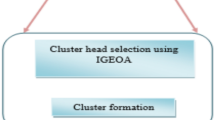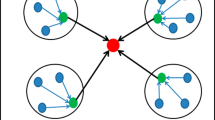Abstract
A wireless sensor network (WSN) is made up of many sensor nodes with insufficient energy, storage, and processing capabilities. Data gathering and transmission to the base station are two of the main responsibilities of the sensor nodes (BS). As a result, the network lifespan becomes the key factor in the successful design of data collection strategies in WSN. In this study, we provide the Enriched energy optimized LEACH (EE-OLEACH) protocol for data transfer. Through a combination of efficient optimum clustering and an optimal route selection mechanism, it provides a means for energy-efficient routing in WSN. The Homogeneous Hunter-Wolf optimization (HHWO) is used for clustering, and a cluster head is chosen for each cluster to reduce energy loss among sensor nodes and maximize efficiency in their use of available resources. Nodes with the highest residual energy may receive the most energy-efficient routing. In order to send the data to BS, the nodes with the greatest residual energy are chosen. The pheromone-profound Ant optimization (PPAO) method was then used to reduce energy consumption throughout the path-selection process. It contributes to a higher packet delivery ratio while reducing power consumption. According to the experimental findings, the proposed EE-OLEACH performs better than the current Protocol in terms of packet delivery ratio, end-to-end latency, and energy usage. In this paper, we compare the performance of the existing hierarchical routing protocols under varying conditions (packet size, starting energy level, etc.) and demonstrate how the optimal CH selection based on a suggested algorithm improves both network lifetime and energy consumption. The Simulation results shows that the EE-OLEACH enhances energy efficiency by 30%, delay by 35%, node survived by 45%, network lifetime by 56%, packet delivery ratio by 47% and throughput by 38% when compared with other existing protocols. The results clearly show that the suggested EE-OLEACH extends the lifespan of the network and reduce the energy consumption.











Similar content being viewed by others
Data availability
Data is available based on the request.
References
Javaid, N., Waseem, M., Khan, Z. A., Qasim, U., Latif, K., & Javaid, A. (2013). ACH: Away cluster heads scheme for energy efficient clustering protocols in WSNs. In 2013 Saudi international electronics, communications and photonics conference (pp. 1–4). IEEE.
Gamal, M., Mekky, N. E., Soliman, H. H., & Hikal, N. A. (2022). Enhancing the lifetime of wireless sensor networks using fuzzy logic LEACH. IEEE Access, 10, 36935–36948. https://doi.org/10.1109/ACCESS.2022.3163254
Babu, M., V., et al. (2022). AE-Leach: An incremental clustering approach for reducing the energy consumption in WSN. Microprocessors and Microsystems, 93, 104602. https://doi.org/10.1016/j.micpro.2022.104602
Jonnalagadda, S., Kattula, S., & Guntuku, R. (2023). Energy-aware MAX-LEACH routing protocol for homogeneous and heterogeneous WSNs. Wireless Personal Communications, 132, 1527–1551. https://doi.org/10.1007/s11277-023-10673-0
Gangal, V., Cinemre, I., & Hacioglu, G. (2024). A distributed leach-AHP routing for wireless sensor networks. IEEE Access, 12, 19307–19319. https://doi.org/10.1109/ACCESS.2024.3359750
Zain-ul-Abidin, M. Maqsood, H., Qasim, U., Khan, Z. A., Javaid, N. (2016) "Improved genetic algorithm based energy efficient routing in two-tiered wireless sensor networks," in 2016 19th International Conference on Network-Based Information Systems (NBiS), pp. 382–386.
Gantassi, R., Masood, Z., & Choi, Y. (2022). Enhancing QoS and residual energy by using of grid-size clustering, K-means, and TSP algorithms with MDC in LEACH protocol. IEEE Access, 10, 58199–58211. https://doi.org/10.1109/ACCESS.2022.3178434
Venugopal, K., Kumaraswamy M., (2020) "EPC: Efficient gateway selection for passive clustering in MWSNs," in QoS Routing Algorithms for Wireless Sensor Networks, ed: Springer, 123–141
Patil, N. S., & Parveen, A. (2021). ACS leach protocol using optimized clustering and improved orthogonal matching pursuit in WSN. International Journal of Information Technology, 14(1), 175–184. https://doi.org/10.1007/s41870-021-00791-y
Dhumane, V., & Prasad, R. S. (2019). Multi-objective fractional gravitational search algorithm for energy efficient routing in IoT. Wireless networks, 25, 399–413.
Sureshkumar, C., & Sabena, S. (2020). Fuzzy-based secure authentication and clustering algorithm for improving the energy efficiency in wireless sensor networks. Wireless Personal Communications, 112, 1–20.
Gülbaş, G., & Çetin, G. (2023). Lifetime optimization of the LEACH protocol in WSNs with simulated annealing algorithm. Wireless Personal Communications, 132, 2857–2883. https://doi.org/10.1007/s11277-023-10746-0
El Idrissi, N., Najid, A., & El Alami, H. (2020). New routing technique to enhance energy efficiency and maximize lifetime of the network in WSNs. International Journal of Wireless Networks and Broadband Technologies (IJWNBT), 9, 81–93.
Maitra, T., Barman, S., Giri, D. (2019). Cluster-based energy-efficient secure routing in wireless sensor networks. In Information technology and applied mathematics: ICITAM 2017 (pp. 23–40). Springer Singapore.
Tomar, M. S., & Shukla, P. K. (2019). Energy efficient gravitational search algorithm and fuzzy based clustering with hop count based routing for wireless sensor network. Multimedia Tools and Applications, 78, 27849–27870.
Sajwan, M., Gosain, D., & Sharma, A. K. (2019). CAMP: Cluster aided multi-path routing protocol for wireless sensor networks. Wireless Networks, 25, 2603–2620.
Jyothi, A. P., & Usha, S. (2019). MSoC: Multi-scale optimized clustering for energy preservation in wireless sensor network. Wireless Personal Communications, 105, 1309–1328.
Subashini, S., & Mathiyalagan, P. (2020). A cross layer design and flower pollination optimization algorithm for secured energy efficient framework in wireless sensor network. Wireless Personal Communications, 112, 1–28.
Mood, S. E., & Javidi, M. M. (2019). Rank-based gravitational search algorithm: A novel nature-inspired optimization algorithm for wireless sensor networks clustering. Cognitive Computation, 11, 719–734.
Shagari, N. M., Idris, M. Y. I., Salleh, R. B., Ahmedy, I., Murtaza, G., & Shehadeh, H. A. (2020). Heterogeneous energy and traffic aware sleep-awake cluster-based routing protocol for wireless sensor network. IEEE Access, 8, 12232–12252.
Thangaramya, K., Kulothungan, K., Logambigai, R., Selvi, M., Ganapathy, S., & Kannan, A. (2019). Energy aware cluster and neu-ro-fuzzy based routing algorithm for wireless sensor networks in IoT. Computer Networks, 151, 211–223.
Salem, O. A., & Shudifat, N. (2019). Enhanced LEACH protocol for increasing a lifetime of WSNs. Personal and Ubiquitous Computing, 23, 901–907.
M. Parvathi, Pandimurugan (2012) "A study on soil testing using SOA and its future considerations," 2012 International Conference on Computing, Electronics and Electrical Technologies (ICCEET), Kumaracoil. 894–899, https://doi.org/10.1109/ICCEET.2012.6203895
Sarkar, D., Choudhury, S., & Majumder, A. (2021). Enhanced-Ant-AODV for optimal route selection in mobile ad-hoc network. Journal of King Saud University-Computer and Information Sciences, 33(10), 1186–1201.
Divya, K., & Srinivasan, B. (2021). Energy-aware-AODV: Optimized route selection process based on ant colony optimiza-tion-bacterial foraging algorithm (ACO-BFA). European Journal of Molecular & Clinical Medicine, 8(3), 3938–3950.
Ghaffari, A. (2015). Congestion control mechanisms in wireless sensor networks: A survey. Journal of network and computer applications, 52, 101–115.
Seyfollahi, A., & Ghaffari, A. (2020). Reliable data dissemination for the internet of things using harris hawks optimization. Peer-to-Peer Networking and Applications, 13, 1886–1902.
Lakshmanan, S. K., Shakkeera, L., Pandimurugan, V. (2020) "Efficient auto key based encryption and decryption using GICK and GDCK methods," 2020 3rd International Conference on Intelligent Sustainable Systems, Thoothukudi, India, pp. 1102–1106, https://doi.org/10.1109/ICISS49785.2020.9316114
Zhang, D., Wang, J., Fan, H., Zhang, T., Gao, J., & Yang, P. (2021). New method of traffic flow forecasting based on quantum particle swarm optimization strategy for intelligent transportation system. International Journal of Communication Systems, 34, e4647.
Maheshwari, P., Sharma, A. K., & Verma, K. (2021). Energy efficient cluster based routing protocol for WSN using butterfly opti-mization algorithm and ant colony optimization. Ad Hoc Networks, 110, 102317.
Bhargava, D., Prasanalakshmi, B., Vaiyapuri, T., Alsulami, H., Serbaya, S. H., & Rahmani, A. W. (2022). CUCKOO-ANN based novel energy-efficient optimization technique for IoT sensor node modelling. Wireless Communications and Mobile Computing, 2022(1), 8660245.
Funding
The authors extend their appreciation to the Deanship of Scientific Research at King Khalid University for funding this work through large group Research Project under grant number RGP2/403/45.
Author information
Authors and Affiliations
Contributions
All the authors have contributed in equal manner.
Corresponding author
Ethics declarations
Conflict of interest
There is no conflict of interest among the authors.
Ethics approval
Authors provide the ethics approval for the given manuscript.
Consent to publish
All the authors gave permission to consent to publish.
Additional information
Publisher's Note
Springer Nature remains neutral with regard to jurisdictional claims in published maps and institutional affiliations.
Rights and permissions
Springer Nature or its licensor (e.g. a society or other partner) holds exclusive rights to this article under a publishing agreement with the author(s) or other rightsholder(s); author self-archiving of the accepted manuscript version of this article is solely governed by the terms of such publishing agreement and applicable law.
About this article
Cite this article
Rajaram, V., Pandimurugan, V., Rajasoundaran, S. et al. Enriched energy optimized LEACH protocol for efficient data transmission in wireless sensor network. Wireless Netw (2024). https://doi.org/10.1007/s11276-024-03802-5
Accepted:
Published:
DOI: https://doi.org/10.1007/s11276-024-03802-5




